Most people use a bobbin holder when they tie flies. In spite of being a simple tool there are some pretty advanced models out there
A bobbin or a thread bobbin is the spool that holds your fly-tying thread and if you aren't one of the magicians who tie in the hands with basically no tools, you need something to hold that bobbin.
You need a bobbin holder.
Some people just call the tool a bobbin, but to me the bobbin is the thread spool, and the bobbin holder holds that spool. Your mileage may vary.
Simple tool
In most cases the bobbin holder is a very simple tool with two wire legs that grab the thread spool under tension and feeds the tying thread through a tube. The construction gives you something to hold on to and makes sure that the thread doesn't come uncontrollably fast off the spool simply caused by the friction between the holder and the bobbin.
You can even let it hang under the fly while pausing your tying, preparing materials or assessing your work, and the weight of the bobbin and the holder will provide enough tension to keep the fly from unraveling.
... and yet
Broken down in its basic parts most bobbin holders have three of which the two are basically identical. There's a tube and two legs.
The holder is mostly Y-shaped or wishbone shaped, and you pinch the spool between the two legs and feed the thread through the tube. You are ready to tie.
But in spite of being really simple there's a lot of different models out there from the really primitive, just consisting of the above parts, to the very complex and elaborately constructed with nuts, springs, washers, tension adjustment and many intricate details.
Even the simple ones may not be as simple as they seem. The material choice in the arms and not least in the "hubs" which hold the bobbin is critical. Some manufacturers use plastic, some use Teflon, nylon or delrin while other use metal - steel, brass or aluminum.
The anatomy of a bobbin holder
This schematic drawing shows a simple wishbone or Y-shaped bobbin holder. I have put on the terms that I use in the article. As mentioned there are numerous other constructions, but this is the most common one, and might help understanding some of the text descriptions better.
A short explanation of the function of each part:
Tube: this tube feeds the thread in a controlled manner and allows you to move the thread close to the hook or materials without your fingers being in the way. Some are made from steel while others are fully ceramic. If not lined, the inside of steel tubes should be polished very smooth.
Lining: some steel tubes are lined, mostly with a ceramic tube, but you will also find titanium and Teflon lined tubes. The lining isn't necessarily full length, but usually made as funnel shaped inserts that sit in each end of the outer tube.
Legs: these are mostly symmetrical, springy steel wire legs, bent into shape to match the width of the bobbin. They can be several pieces fused together or one piece bent into shape. The legs can mostly be bent to different positions to adjust the pressure on the bobbin, but some models have different mechanisms to adjust tension by pressing on the legs with a sleeve that slides back and forth. On some bobbin holders the legs are made from flat plate. On a few they are more intricately shaped in either molded plastic or metal plate.
Handle: some bobbin holders have a handle added, oftentimes a brass, aluminum or wooden handle that gives you something to grab on to. Shapes differ, but the most common ones are a tapered cylinder, a rectangle or a flat disc. Some have a rubber sleeve slid over the handle for better grip.
Hubs: the hubs are conical cylinders or whole or half balls, meant to grab the bobbin, allowing it to spin under tension. Materials vary from aluminum, steel and brass to plastic and even nylon, Delrin or Teflon.
Metal, ceramics, foam
One other really critical part of the bobbin holder is the tube and in particular the inside of the tube. In principle this could simply be the inside of the metal tube, but for practical reasons it's often lined with an other material.
The reason for this is that the tube metal has a tendency to wear the thread unless polished to perfection, which is difficult on the inside of a thin tube.
Wearing the thread is undesirable because the worn thread will break or at least fray, which is very unwelcome when tying. Some of the cheap and really badly made bobbin holders will simply cut the thread under the least bit of tension, and are essentially useless for normal tying threads.
Lining with ceramics is the most common method of countering the wear, and most modern bobbin holders have an inner tube made from a ceramic material while others simply have a full ceramic tube with no metal around it. Other high-end bobbin holders have a meticulously polished metal tube, which will of course work just as well. An important difference between ceramics and metal is that metal leads away heat much better than the highly insulating ceramic materials, thus keeping the thread from heating up, which is undesirable and can weaken the thread, affect waxed thread and have infleunce on the tying.
One single brand - C&F Design - offers a slitted foam plug in the rear of the tube, which will keep the thread from accidentally being pulled out of the tube, but also always requires that a stiff threader is used to thread the bobbin holder.
Tension
One of the prime tasks of the bobbin holder is to feed out the thread perfectly, preferably under a constant tension, which should ideally be close enough to the breaking strength of the thread to enable you to tighten your wraps as much as possible without risking to break the thread.
On most plain holders you obtain this by bending the legs to the desired pressure on the spool. Others have different adjustment systems that let you adjust pressure by screwing on a screw, a nut or a threaded knob while others again have a sleeve that slides over the legs to increase and decrease tension.
No matter whether the adjustment is done one or the other way, the final friction in these holders is partly dependent on the thread spool material, the shape and size of the hole and the bobbin holder hub and even the material of the label if that is still on the bobbin.
The bobbin holders that promise more constant tension mostly grab the spool tightly and relies on friction between parts on or in the bobbin holder rather than between the bobbin and the tool to keep the tension constant. Some of these have fairly advanced spring based tension systems, a main feature of the retracting bobbin holders covered later.
Flat
A few bobbin holders are wishbone shaped and use the spring tension of the legs to control the thread, but are made from plate rather than wire.
This gives a sturdier construction and more surface to hold on to and also enables the manufacturer to control the orientation of the "hubs" better, which keeps tension and friction more constant. But it also limits the flexibility when it comes to using different spool sizes and adjusting tension by simply bending the material, because the plate is often stiffer than the wire.
Curved
Some wire bobbin holders are symmetrical on one axis but curved on the other, mainly to offer a better fit in the hand. The curved models are mainly standard wishbone bobbin holders that have been slightly bent in the legs, and if you aren't intimidated by the thought, you can easily convert your own straight Y-shaped wire bobbin holder to a curved ditto.
Asymmetric
While the standard construction is a basic Y-shape, a few bobbin holders are asymmetric. Some have just one leg, but are fundamentally made like the symmetrical ones, while others are really asymmetrical made in that way to better fit your hand and aide the hand and thread position while you tie. Both Ekich's, Rite's, Apex Predator Bobbin and Stonfo's bobbin holders belong in the first category while the Jvise J Bobbin from Jay Smit is the only truly asymmetrical bobbin holder I know of.
These holders may fit well in the hand, but do have a severe disadvantage in my eyes, namely the inability to spin in a controlled manner. Even the one legged holders such as the ones from Rite will not be able to spin properly, and for those of us who routinely spin the bobbin holder to untwist and flatten thread, that's a party spoiler. While many of these tools are nice to use for wrapping thread, I personally can't use them daily because spinning is such an important part of my tying.
Retracting
A couple of the bobbin holders covered here feature a retraction mechanism. I have included the only two I know of in this article: Norm Norlanders Norvise Bobbin and Faruk Ekich's Ultimate Fly Tying Bobbin.
When using normal bobbin holders, the tyer manually winds the surplus thread onto the spool while keeping tension on the materials and the thread. The retracting tools have a built-in spring mechanism that makes them pick up and release thread as you move the bobbin holder closer to and away from the fly.
The advantage is of course that you don't have to rewind thread, but simply move the tube of the bobbin holder wherever you want to, and it will immediately pick up any slack. Tying with such a tools requires some getting used to, but once you have tried it, you quickly learn to appreciate it.
Since the spring mechanism in such holders cannot feed an infinite length of thread and still retain the same tension, they have different mechanisms for releasing and re-tensioning the spring and the thread. The Norvise Bobbin allows the bobbin or spring mechanism to "slip" when it reaches a certain tension and that way resetting the spring. Faruk Ekich's bobbin holder requires that you release the bobbin from the contact and clutch plate, resetting the spring. The operation sounds more cumbersome than it is, and it can easily be done with one hand while tying.
Multiple functions
A few bobbin holders have more functions, and one function that has been built into bobbin holders is the dubbing twister.
This makes pretty good sense since the bobbin holder essentially already has the shape and weight needed. All it needs is a way of holding the loop. Three of the bobbin holders mentioned here have this function: Mitch's Bobbin Whirler from Wasatch, the French HookBobbin and the MP-TT Bobbin from Marc Petitjean.
They can all grab the thread and spin dubbing and hackle loops, but have different ways of achieving this and also come at different prices, the Petitjean bobbin holder being about twice the price of the ones from Wasatch and HookBobbin.
Spool size
Most traditional bobbin holders will hold bobbins from different manufacturers. These are generally quite identical, but can vary a bit in dimensions and capacity and quite a lot in shape.
A few bobbin holders are less flexible due to their more rigid construction like the J Bobbin, C&F design and others made from plate. They can still handle most bobbins, but the ones too extreme will not fit perfectly.
Some bobbin holders are made for one size of spools, and the Ekich Ultimate Bobbin is designed for standard spools and need a bobbin that has the proper outer and inner diameter as well as some sprocket holes for the clutch plate to engage in. Many spools will work with Ekich's holder, and both UNI's, Danville's, Wapsi's, Bennechi's and Veevus' spools and many more work fine.
Norlander's bobbin holder holds only the specially designed Norlander spools.
Other bobbin holders are built to hold the older, narrow bobbins, which are about a third of the width of the modern ones, and will not fit in a bobbin holder made only for standard spools. Some types of thread, mainly the classical Pearsall's Silk, comes on these narrow spools and will require a special bobbin holder that can apply enough tension on the smaller spools, You will also see tyers that re-spool their thread to sewing machine bobbins, which are much smaller than the standard tying thread spool. Most plain wire bobbin holders can be bent to fit these smaller spools, but you can buy tools that are already dimensioned for the narrower spools.
If you are a tyer who uses many brands of thread, you need to make sure that your bobbin holders can hold many types of spools - or you may be forced to buy bobbin holders for these special cases or even re-spool the thread to more common spools.
Home made
People make their own bobbin holders, which may sound like a good idea given the simple construction, but it hardly yields a product which can match the commercial products. Considering the moderate prices of decent bobbin holders, I'd stay off the DIY path, but for people with access to good tools and materials, it might be worth a try. But don't expect to save much money. The least expensive quality bobbin holders cost just 10-15 US$, which can hardly be matched if you want to make a quality product yourself.
The cheap ones
Most of us started out buying cheap bobbin holders in spite of all good advice. So we now have one or a couple of Indian or Chinese tools laying around, way inferior to the brand name bobbin holders, and not very useful for tying with normal tying thread.
But they can be useful anyway. Use them for chenille, wire or very thick thread or thin yarn. This will enable you to control the material, and even the lousiest thread-fraying bobbin holder won't be able to do much damage to chenille or a copper wire. More like the other way round.
You might not have the material on a suitable spool, but you can either re-spool it on used thread spools or simply leave the spool or loose material dangling, and just use the bobbin holder for control.
Even though it's often recommend using a bobbin holder for floss, don't be tempted to use a degraded non-name tool for this. Floss frays like nothing else, and will require a top notch tool.
What to choose
Personally I have chosen a long time ago and have been tying with Griffin Enterprises' ceramic bobbins for a very long time. While visiting the manufacturer in Colorado a couple of decades ago I purchased a handful, and they have served me very well ever since. Since I like to keep my thread on the bobbin holders and not have to change whenever I change thread, I purchased an extra handful of bobbin holders soon after. I don't remember where and I don't remember what brand they were - if any. They are ceramic, nicely made and slightly larger than the Griffins and have worked equally well.
I have tried a number of the more complex and fancy models but always returned to the simple ones that do the job well for me.
I can see the idea with the retracting bobbin holders and could get used to tying with one, but find the resetting of the spring and the extra "thinking" involved a little tedious. The same goes for holders with adjustable tension. I'm sure some people love them, but I have adjusted thread tension by bending wire legs for decades, and that has worked fine for me and have no desire for a more precise adjustment mechanism - especially not when it comes with complex spool shifts and loose parts.
Bob Petti's notes
GFF partner Bob Petti added these valuable notes to the article.
I have not done much experimentation with bobbin holders. I have several - but other than the cheap Indian one that came with my original kit (that I still use), they are all Griffin. I initially spent the money for ceramic, but have found for my tying a simple metal tube works just as well. My two main threads - black and white - are always loaded in the ceramic bobbins since they get the most use and would see the worse wear. I would not advise anyone to have a great variety of bobbins on their desk (variety being styles or manufacturers) as changing back and forth could introduce a different feel. Changing threads should not change the tying experience - the bobbin should disappear in your hand to be never thought while tying. So while experimentation is good - my advice would be to pick one style and get multiples of that style and sell the rest - to establish a good relationship with the bobbin so its use becomes mindless. And learn to tie with the bobbin in the hand at all times.
I set the tension fairly loose and mostly regulate it with my hand while tying - unconsciously. Too loose of course is no good - but too tight is no good either. Mine are considerably less than breaking strength of the thread - but I can snap the thread by squeezing the bobbin in my hand if needed.
My only other piece of advice would be to discard a bobbin if it starts to cut thread - but first prove that it is the bobbin by using different threads spools. If not discard - demote it to wire use only. I've seen all sorts of homemade remedies to polish and smooth a bobbin tube if they become ragged - but I'd rather spend my time tying flies. $8 for a new bobbin outweighs whatever time and angst associated with trying to fix something that is essentially disposable. With Griffin - I think that has happened to me once in 20+ years of tying.
Stick with a reputable brand - buy cheap - and buy many. That's my advice for bobbins. Expensive bobbin holders - with fancy wood accents or automatic feeders and other advanced mechanisms - usually means fewer on the tying desk and more time spent changing threads and less time tying flies. Gizmos and gadgets are fun - to a degree.
Bob Petti
Brands
Here's a list of different bobbin holders. I own or have tried most of them, but not all of them, so some of the opinions expressed here are based on what others say and what I have picked up from written material and photos of the different tools.
I have tried to get samples of all the tools, but not all manufacturers have replied.
You can click on the manufacturer's names to go to their web sites. Some have direct sales, others link to retailers.
Standard wishbone/Y-shape bobbin holders
There's a whole bunch of these good quality, polished steel or lined bobbin holders on the market from well known manufacturers as well as some lesser known brands.
Look for Griffin's, Dr. Slick, Renzetti, TMC, Orvis and other brand names.
I have also stumbled on some lesser known names like Ken Newton, Turall, Zona and others, which seem fine but not that widespread.
The tubes are either polished inside to high standards or lined or tipped with smooth ceramic, titanium or even Teflon to protect the thread.
|
|
Dr. Slick
Dr. Slick tools need little introduction and the bobbin holders live up to the quality known from other tools this company. Three lengths with Delrin hubs are available and you can choose between ceramic and titanium oxide funnel inserts.
Price: From 13-23 US$
Griffin Enterprises
Simple, no-nonsense and high quality bobbin holders with nylon hubs. Available in several sizes and models, both with bare steel tubes and ceramic inserts.
Price: From 8-13 US$
|
|
Orvis
Available in several models including a curved one.
Price: App. 16 US$
|
|
Renzetti
From the well known vise manufacturer and fully up to their standard. Several models available including Teflon lined and ruby tipped ones as well as a cruder one meant to be used for wire.
Price: from 17-24 US$
Semperfli Fly Tying Bobbins
The Semperfli bobbin holders are very no-nonsense and made to high standards. They are available in several models with different shapes and sizes, different "handles" and different hub materials all lined with ceramics to protect the tying thread..
Price: From less than 15 US$
|
|
|
|
|
|
|
|
|
TMC/Tiemco
Solidly made, simple with full ceramic tubes. Available straight and curved in standard and heavy duty versions.
Price: From 16-20 US$
Umpqua
US manufacturer and distributor Umpqua has several bobbin holders, quite plain, solidly made and with full, ceramic tubes. The Standard model has a flat brass handle while the Suregrip series has a larger rubber handle providing a better grip.
Price: From about 10 US$
All of the above are typically simple, very well made and pretty inexpensive. They do exactly what they are supposed to: hold the spool and feed thread under constant tension.
The tension is simply adjusted by bending the legs and loose thread is rewound manually.
Price: Typically between 10-25 US$ depending on brand and model.
Pros: Simple, efficient, inexpensive.
Cons: None.
More bobbin holders
The group below consists of some bobbin holders which are not just two wire legs and a simple construction and some with the usual construction - some with variations like the Norlander bobbin holder, which has a normal shape holder, but different spools or the Wasatch holders with wooden handles and added functions. Some don't use wire but plate, some use far more intricate constructions. Some don't even grip the bobbin on two sides.
Apex Predator Bobbin
This was a project started by Swedish Ilias Fn Karanzas on the crowd funding site Kickstarter in mid 2016. I immediately jumped in and signed up for a bobbin holder.
The price was (and still is) pretty steep, but I like to support these projects, and the bobbin holder did look quite cool in the computer renderings provided.
The delivery was estimated to be March 2017. I started writing this late October 2017, on the day that the Apex Predator Bobbin came in the mail – in other words 6 months delayed. That is unfortunately often the story of these crowd funded projects. Delays are simply a part of the game.
The Apex Predator Bobbin is a pretty cool design, utilizing a carbon fiber frame and some anodized aluminum parts available in several colors. It's an asymmetrical, one-legged bobbin holder with a frame that's open on one side, like it's found on Faruk Ekich's tools, particularly the 2015 model, which the Apex does resemble quite a bit.
The ceramic tube is adjustable through a simple mechanism, a nice, but not extremely useful feature.
You change the spool by unscrewing the discs that ride on the threaded axis. There are two separated by a nylon washer. You need two because you have to counter tighten them in order to secure them. There isn't much space, and since the discs are smaller in diameter than the typical thread spool, getting a proper grip on the inner one is particularly hard. Making the inner disc just slightly bigger could have solved this problem and made the adjustment much easier and more precise. Right now it's a bit of a trial and error game to get the same thread tension when changing spools.
I have been tying with the bobbin holder quite a bit, and while it is both good looking and has very good reach for large flies, I'm annoyed by one thing: the thread spool often sticks to the hub and will require a little jerk to come loose before the thread is released evenly. If you adjust the tension just on the brink of the breaking strength of the thread as some tyers prefer it, you will risk breaking the thread when pulling off fresh thread because the spool sticks. This is probably due to the spool resting against the anodized metal rather than nylon or Delrin, and the stickiness varies with the spool type used. I also experienced that some spools tended to give off thread very unevenly. I couldn't see what caused this, but changing the spool was the only solution.
The tool is quite large, and for some tyers it might be just on the beefy side like the Loon Bobbin or the Rite Mag models. Some like large bobbin holders, some don't. The Apex Predator fit my hands nicely.
The Apex Predator Bobbin is differently designed, nicely made and certainly an eye catcher. But its finish and function is a bit lagging, and it doesn't quite deliver for the price.
Price: 60-70 US$ or about 50 GB£
Pros: Nice design, suited for large flies.
Cons: Has to be taken apart and readjusted to change thread. Many thread spools tend to stick. Expensive.
|
|
C&F Bobbin
The Japanese C&F brand is known for its modernistic products featuring designs that differ from tradition, and that is also the case with their bobbin holders. The construction and shape is different and the bobbin holder is the only one in the market to feature a foam core in the rear of the tube to add tension to the thread and keep it from slipping out when it's slack. This does mean that the bobbin holders require a stiff threader to pull the thread through the tube. The threader comes in the package.
Price: 45 to 50 US$
Pros: Solid construction, foam retains slack thread.
Cons: Fairly expensive, requires included tool to thread.
Ekich Ultimate Bobbin
AKA the Ekich automatically-retracting bobbin. With a price tag of 100 US$ you are allowed to expect something else, and that's what you get. It's by far the most expensive bobbin holder out there even counting the steeply priced offerings from Marc Petitjean and C&F Design, but it also offers supreme craftsmanship and a very sublime and precise retraction mechanism.
The prime virtue of this bobbin holder compared to other models is of course that it automatically rewinds the thread. It also works with a very constant and precise thread tension, specifically set to protect the finest thread such as UNI's 17/0 Trico, offering the maximum thread control and force.
According to some this leads to greater tying speed and better hold on material per wrap, which of course might be true, but then again should be obtainable with most good bobbin holders provided you adjust tension properly.
It's a very beautifully made piece of mechanics and when tying with it you soon learn to appreciate and master the delicate function. Many avid Ekich bobbin holder fans declare that they will never go back to a normal tool after having tied with this model.
Ekich has brought a new model to the market called the S-Series, made with a slightly simpler production method and also less expensive than the hand made original. The S-Series was introduced in the Fly Tyer 2014 Winter Issue and at the International Fly Tying Symposium - both in November 2014.
Price: 100 US$ plus shipping. The S-Series model is 70 US$.
Pros: Retracts thread, no adjustment needed, easy spool change.
Cons: Manual reset of spring mechanism, expensive, doesn't fit all bobbins.
HookBobbin
The French HookBobbin is another new bobbin holder, introduced to the market in 2015 and featuring some different design details compared to the standard models on the market.
At first glance it looks like any Y-shaped wishbone bobbin holder, but upon closer inspection you realize two major differences. Firstly the friction on the bobbin is not only provided by pressure on the outside of the spool, but also on the inside. One hub on the bobbin holder has a longer stud that protrudes into the center of the spool, and by turning a small knurled knob on this hub, you expand a small silicone-like cylinder, which will fit increasingly tight inside the spool. This provides a very finely adjustable thread tension. The HookBobbin has tension even without this mechanism, and can basically be set like most other, simpler bobbin holders by adjusting the leg position, but the knob gives an added and finer control.
The second thing to remark is that the hook in the name HookBobbin comes from two small hooks hidden inside the handle of the bobbin holder. These can slide out and will act as dubbin spinner hooks, allowing the bobbin holder itself to act as a dubbing spinner. The operation takes a little getting used to and is best suited for smaller flies an small amounts of dubbing (compared to larger flies and hair hackles), but works well. Since the loop is created by three threads and the finished dubbing rope sits nicely on the bobbin holder, wrapping the dubbing is quick and easy. I can see the practicality in the construction, but have to admit that I was slightly bothered by the hooks, which protrude a little from the handle, even when not in use, and they annoyed me a bit the way I grabbed the tool.
Overall the HookBobbin is well made and works just as intended.
Price: 39.- Euros with VAT inside EU, 32.50 Euros or about 35 US$ elsewhere.
Pros: Well made tool, very precise adjustment, built-in dubbing spinner function.
Cons: Slightly complex, spinner hooks can be annoying. A bit expensive.
Jvise J Bobbin
The J Bobbin is a peculiarly looking construction, which definitely takes the prize as the "most asymmetrical bobbin holder". The construction made by South African Jay Smit is pretty complex, but the result is a bobbin holder that is more ergonomic and gives you better control and a better hand position while tying. It's very comfortable to tie with and allows for very precise tension adjustment. It's surprisingly inexpensive considering its complexity and quality.
Changing the spool requires a thumbscrew to be loosened and the spool to be slipped in. After that you adjust the tension with the same screw.
Price: 30 US$
Pros: Ergonomic, finely adjustable.
Cons: Slightly complex spool change requires readjustment. Asymmetrical, not suited for spinning.
Loon Ergo Bobbin
The Loon Ergo Bobbin is a man's bobbin holder, in the sense that it's a very sturdy and large tool. This may not appeal to everybody, but for people tying larger flies using heftier threads, this is the answer to a long standing prayer. It's not like you can't tie small flies or use thin threads with the Loon tool, because you can, but it stands out in size and reach, and will outdo most other bobbin holders in that respect.
It's characterized by a large, soft, yellow grip – a trademark for the whole series of new 2016 Ergo Loon tools – and is made with plate legs and a long steel tube.
The mounting and adjustment is easy and straightforward and tension can be set from very hard to almost free run. My only grudge with this excellent tool is that I had a squeaking noise from some bobbins, probably due to the steel hubs, which are hard and slightly coarse. The noise disappeared once the inside of the plastic bobbin had literally been ground down a bit by the steel in the hubs. It's an extremely durable construction, no doubt, but nylon or Delrin might have been a better choice.
I still like the way this bobbin holder handles and have been using it extensively for tying pike flies and larger streamers ever since I got it.
Price: US$ 19.95
Pros: Solid construction and great size for larger flies. Very good value for money.
Cons: Slightly large for some applications. Squeaky hubs with some bobbins.
Norvise Bobbin
US fly tyer Norm Norlander is best known for his rotary Norvise, and to go with that he has made the Norvise Bobbin, a bobbin holder that retracts thread and should work particularly well with his special vise.
The holder requires a special spool, so you can't mount your ordinary spools right out of the box, but have to re-spool the thread to specially designed narrow and large diameter metal spools. The bobbin holder comes with one, so unless you tie with one color thread only or are willing to constantly re-spool (very impractical), you can get a kit with a bobbin holder and four spools and buy extra spools as you need them. Ten spools will run you about 35 US$.
Re-spooling can be done with an electrical drill or on Norlander's own spinning vise using an arbor that comes with the kit or can be acquired separately.
The tool is very well made and after a little getting used to, you soon learn to appreciate the function. It retracts thread in a very controlled manner and can be reset simply by pulling out enough thread thanks to a slipping clutch mechanism built into the spring hub. In spite of its odd shape - or maybe exactly because of this - it fits very well in the palm of your hand.
Price: 45 US$ and 65 US$ for the kit.
Pros: Rewinds thread, ergonomic.
Cons: Requires special bobbins and thread re-spooling. Relatively expensive.
Petitjean MP-TT Bobbin
|
|
The MP-TT Bobbin is made with a number of extra features as it's often the case with Swiss Marc Petitjean's products.
The bobbin holder can be threaded from "the outside" without tools and without having to pull the thread through the tube.
The tube also has a hook which enables the bobbin holder to double as a dubbing twister and the bobbin holder has a sliding tension adjustment, which allows you to easily adjust the pressure on the thread spool.
Price: 46 Euros or about 60 US$
Pros: Easy threading, spinning feature, easily adjustable thread tension.
Cons: Fairly expensive.
Rite Bobbin
The Rite Bobbin uses a slightly different way of holding the thread spool than most bobbin holders. Having just one leg and utilizing a number of washers, a loose end piece and a "screw", the Rite requires you to unscrew the bobbin holder assembly to change spools and set the tension for each new spool. The operation is easy and works smoothly, but does take a little time and involves loose parts.
But it leads to what Rite refers to as micro-adjustable tension, in other words very precise and constant tension on the thread, which combined with the well constructed bobbin holders lead to very good thread control. The bobbin holders do only have one leg, which might feel strange to hold for some tyers while others will love it.
Price: 22-32 US$ depending on model.
Pros: Micro-adjustable tension, solid construction.
Cons: Loose parts, complex spool change, adjustment required after spool change.
|
|
|
|
|
|
|
|
|
|
|
|
S&M Bobbin
The S&M is a classic bobbin holder, which has been around for a very long time. And it does look kind of fiftyish in its design, which is loved by many.
It was originated by the late Walter Stockman & Charlie Malley of the S&M (Stockman & Malley) fly tying shop in Bristol CT back in the late 40s early 50s. Later it was purchased and distributed by John Marona & Kevin Pelletier of Quiet Sports on the banks of the Farmington River. Their shop closed around 2006-2007 and Nick Masi took over in 2011. It's still manufactured and assembled in New England, USA.
It's a plate bobbin holder, holding the bobbin with wide, springy plate legs, which due to the construction will fit certain spools way better than others. Too large or too small bobbins can be hard to give the proper hold and tension. There's a short and a long tube version with no frills steel tubes. This old school bobbin holder is still used and loved by many tiers, and is very inexpensive in spite of being US made. Unfortunately it doesn't ship outside the US from the manufacturer, but it can sometimes be found in other shops. Wasatch makes a wood handle version on the same base, which can also be hard to find, but might be easier to track down outside the US - at a higher price though.
Price: 5 US$
Pros: Simple and no frills construction, very inexpensive.
Cons: Quite rigid. May not fit some bobbins.
SMHAEN Pro
These Danish produced bobbin holders are visually very different from most bobbin holders and also use a unique way of tightening the legs to hold the thread.
The bobbin holders are two legged of the plate type, having flat legs and a separately mounted round metal tube, which holds a ceramic tube that feeds the thread. The greatest difference to other bobbin holders is the tightening mechanism, which allows you to screw and unscrew a central, elongated nut that grabs a small bolt in each side. The springy action of the legs press them apart, while the bolts and the nut is used to bring them back together.
You loosen the legs, mount the bobbin between the hubs and tighten the legs to your taste. Then you feed the thread through the tube and you are ready to tie.
The process is a bit cumbersome, but once the leg pressure is set, the control is extremely good, and the bobbin holders feel really great in the hand. The SMHAEN bobbin holder comes in two sizes: long/red and short/blue (AKA midge). The long model fits perfectly in my hand and suits my style of tying very well, but I wouldn't have problems using the shorter model on a daily basis. I just like the slightly longer reach.
Altogether a great product with a really nice and cool design.
The SMHAEN bobbin holders are available in the US from Dakota Angler & Outfitter priced at about 70 US$.
Price: 54 Euros or approximately 45 UK£ or about 60 US$.
Pros: Very nice design, solid make and feel and extremely good thread control.
Cons: Slightly complex bobbin mounting, which requires an adjustment for each thread change. Expensive.
SMHAEN Classic
When Danish Stig Hansen introduced the first SMHAEN bobbin holders, I liked them, but did find them a bit on the complex (and expensive) side, still preferring my good old-fashioned, simple wishbone style tools.
But a few years ago, Stig launched a set of simpler bobbin holders called Classic, still looking as good as the old ones, still made up to the best standards, but much simpler in construction, adhering to the traditional wishbone method of holding the bobbin.
I really like these tools and have been tying with them quite a bit. In my eyes they are easier to handle and use compared to the Pro model – not least when changing thread – and their tension is exactly as I like it: just a whee bit on the tight side, still feeding out thread smoothly and consistently.
I have had no need to adjust them, but should the need arise, it’s a question of simply pressing or pulling on the legs to get the thread tension you like.
As an added bonus, these newer models are also less expensive than the old ones. Not cheap, but not quite as steeply priced as the Pro models.
Price: US$ 45-50.-
Pros: Solid construction, great design and mechanically impeccable. Available in two sizes.
Cons: Still on the expensive side compared to some of the simpler offerings in the market.
|
|
Stonefly Thread Bobbin
The Stonefly bobbin holders are made from a material rarely used for these tools: plastic. Stonefly produces two models SF2 Thread Bobbin and SF26 Long Tubed Thread Bobbin with a wide Y-shape and a rubber handle.
Thoughts about these bobbin holders vary quite a bit, but several tyers report that they are brittle and break easily.
UK manufacturer Stonefly makes several other fly tying tools, but one really brilliant little item is the Bobbin Spacer, which allows you to use narrow thread spools in normal width bobbin holders.
Price: app. 16 US$
Pros: Rubber grip.
Cons: Can't be adjusted, reported fragile.
Stonfo Elite Disc Drag Bobbin
Stonfo is an Italian manufacturer of a large variety of fishing tackle and tools, and among them you will find the Disc Drag Bobbins.
As the name implies the bobbin holders have a drag system, and have a threaded axis that enables tension adjustment. The construction is traditional wishbone, but one-legged with a flattened piece of metal at the Y-junction - which is of course not a true Y due to the one-legged construction.
The tools are very well made and all have ceramic bushings in the outer end of the tube. They allow for very accurate and constant tension to be set. Spool change requires the tension system to be unscrewed and the nut as well as the disc to be removed and reset and readjusted once a new spool has been mounted.
Like the Rite bobbin holders the one legged construction falls well in the hand, and the precise thread tension makes these bobbin holders very nice to tie with.
Price: App. 25 US$
Pros: Easily and precisely adjustable tension, solid construction.
Cons: Complex bobbin change requires readjustment, loose parts.
|
|
|
|
|
|
|
|
|
Tiemco TMC Adjustable Magnet Bobbin
The TMC Adjustable Magnetic Bobbin controls thread tension with magnetism, which is a novelty ... that comes at a price. These are announced at 6,600 Yen, which translates into more than 60 US$. And that's before they have been exported from Japan. As with most Tiemco products they are most likely good quality and feature such design details as vertically adjustable ceramic tube, thread keeper, and self-standing design. As it can be seen from the video below, the construction is pretty complex, and adjustment takes several steps.
Price: 60 US$ (in Japan)
Pros: Nice design, potentially very smooth operation. Adjustable tube.
Cons: Price. Complex adjustment with several loose parts.
Wasatch Bobbins
Oregon based Wasatch has a number of different bobbin holders all featuring cocobolo wood handles and varying shapes and functions. They manufacture both standard wire bobbin holders as well as holders formed from plate. Wasatch also offers Mitch's Bobbin Whirler, which has a built-in hook that allows the tyer to spin dubbing loops with no extra tool.
All the tools are beautifully made and the tyer who wants something a little extra when it comes to looks and style as well as quality and function is very well served by the Wasatch offerings. The lineup also includes wooden accented versions of basically all other common tying tools, so the style can be maintained through your whole tool collection.
|
|
The prices for the plain, ceramic bobbin holders are very reasonable, and even the more complex spinning version can be had for just about 30 US$.
Wasatch recently introduced a radically different bobbin holder called the Sidewinder. It's constructed with the spool sitting on the axis of the tool, and feeds off the thread to the side. Being able to revolve, it allows the tier to wrap the material without introducing any twist, which makes the bobbin holder very suited for wrapping floss and other materials – more than being used as a normal tying thread holder. The sidewinder costs about 30 US$.
Price: From less than 15 US$. App. 30 US$ for Mitch's Whirler and the Sidewinder.
Pros: Beautifully finished with wood, many models, reasonable price.
Cons: None.
|
|
|
|
|
|
|
|
|
|
|
|
Indian/Chinese, wishbone
These are the really basic, metal tube bobbin holders that come with any beginner's kit or can be bought for as little as a couple of dollars. They might work ... but mostly they are crudely made and will often fray or break the thread. Some can be well made and work fine, but you don't know before you have used it. I advise you to stay away from these for other applications than wire and coarse yarns.
Price: typically 2-5 US$ depending on source.
Pros: Simple, very inexpensive.
Cons: Crude, often wear and break tying thread, inconsistent quality.
- Log in to post comments




















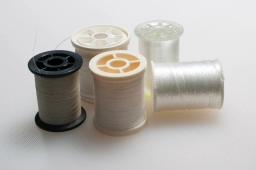







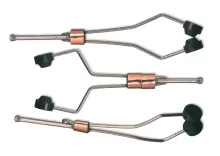




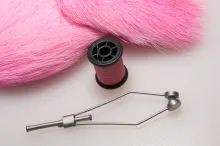
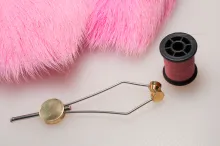








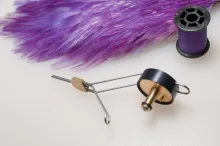



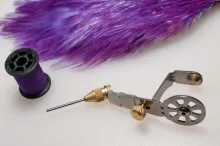











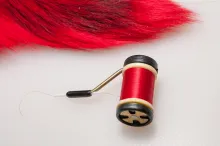



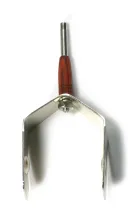

















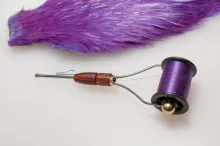













Warranties
Many of the companies offer warranties. So if you get a bad one, ask for a swap.
What is interesting is that some of the tools listed are actually Indian made. Many of these bobbins listed contain components from Chinese or Indian sources , some have Indian feet or frames. In our world economy, items often come many sources. Typically any brass work is usually done in Asia due to issues related to lead and work place health. Most USA, EU and UK manufactures have restrictions working with lead which is contained in brass.
Indian tools tend to have quality all over the place. Well made Indian tools can be quite good. To avoid issue with fraying look for models that have flared or ceramic ends. Those models typically have less issues with fraying. Also Martin is quite right, often the thread can be the reason for fraying.The ends of the tubes are places that usually cut thread. I import Indian tools and have sold hundreds and hundreds of bobbins. They are usually half to a third of the price of domestic bobbins. I have some Indian tools I have used for many years with no issues. Usually the better tools are examined for quality and the bad ones are pulled before the customers see them.
One thing not mentioned is that ceramic tubes can shatter. I have seen several broken ones with ceramic tubes. Tubes with bead ceramic tips can often have issues with beads cracking or breaking. Bob Petti mentions Griffin which is very dependable, well made and easy to use. His basic model is one of the best.
Look at what the tool does and what your expectation is. If you are tying bass or saltwater, or you pull hard, some of the fancy ones aren't the best. Some of the more solid models are the ones with the less expensive price. Feet are my biggest issue. Ball feet makes the bobbin twist and those tend to roll in your hand. I like recessed feet. By far the best model I have ever used is Matarelli. For many years the son ran the company. He stopped making bobbins earlier this spring due to some health issues with his Father. His feet never slipped and the tubes never cut thread because they were polished. A true Matarelli is stamped with his Dad's initials on each side. "FM". Those are gold.
B R I L L I A N T
Martin... B R I L L I A N T !!! [as usual] What a fine information resource... that being said, I'm a long time automatic bobbin user / addict and have NO regrets... with that in mind, I've got some well exercised Ekich and Norlanded bobbins and there's NO going back for me [although there is quite a curious collection of standard bobbins standing by at the ready, just in case... fat chance!...]
To fully appreciate the opportunity that these auto gems afford, consider the common rotary application of a palmered feather tight in the grips of most any hackle plier... you have wrapped the feather and the plier is now left hanging under the hook shaft just waiting to be lashed in place... the automatic thread retraction factor allow you to zip down around the hanging plier than back up close to get a proper bight on the target then back down and around the plier and so on and so forth until the job is secure... snip the remaining feather and whip finish the thread and Bada Bing Bada Boom, the auto rewind function has shown it's promise and made your tying day... It just gets BETTER and BETTER...!!! and then there's dubbing loops and several other tricks that simply SET YOU FREE... I'm a bit ripe to be this breathless... Forgive me, Pleeeze...
Great article Martin
Great article Martin! A very good information of many bobbin holders most of us didn't have or know about. Now we can consider new tools for enjoying even more our tying time.
I use most of the time Umpqua Ergonomic bobbins, a "standard" ceramic bobbin holder with a twist on the handle, a very sturdy and well constructed tool, I have many of those for years working perfectly.
Thanks for sharing this knowledge!
Carlos.
shmaen bobbin price...
There must be a "little" mistake on the price of that bobbin holder, which seems to be a great product,
i've recently ask for a price on Smhaen website: 59€ per bobbin = 65usd, it's no longer 20 usd.
How such a difference is possible in 2 years???
Adjusted
Eric,
I just got a note today from Stig - the manufacturer - himself noting the wrong price, and it has been corrected now. Back when I wrote the article, I didn't have a precise price, and put in the price I could gather from the correspondence with Stig and people who bought the bobbin holder.
Sorry for having the wrong price for so long!
Martin
Smahaen bobbin
Hi Martin,
Late May this year , I contacted Mr. Stig Hansen re:obtaining a Smahaen bobbin in the US. In his reply on May 29 , he told me I could purchase one directly from him for 54 euro plus 25 euro for shipping to the US. I think I posted this here in late May ,early June.
If this price is incorrect , does anyone know the correct price with shipping to the US or if they are available in the US ?.
Best Regards,
Steve Keim
US sources
Steve, as far as I know the only source is Stig directly, but I have inquired about US sources. I guess the postage would be pretty steep if they were to be sent over through ordinary mail. I'll post the information here once I get it.
Martin
No US dealer... yet
Steve, the SMHAEN bobbin holders are slowly hitting the shops this autumn, but mainly here in Denmark and Europe. Stig tells me that he's working on US contacts, but have no serious options yet, so I guess they will eventually be available more locally in the US, most likely with lower shipping costs.
Martin